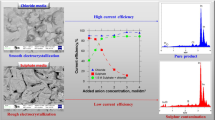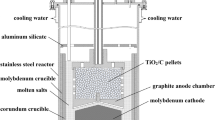Conclusions
-
1.
An investigation into the conditions of formation of fine tin powders from chloride-fluoride electrolytes has shown that finely divided tin is precipitated on the cathode in the form of a black deposit with a current efficiency close to 100% at a cathodic current density of not more than 5 A/dm2.
-
2.
The kinetic parameters of the process of finely divided tin deposition have been calculated. Analysis of the result obtained leads to the conclusion that the tin ion discharge act proper is preceded by a stage linked with oleic acid adsorption on the electrode.
-
3.
The optimum process parameters for the production of finely divided tin under prolonged electrolysis conditions are as follows: 150 g/liter SnCl2 · 2H2O, 60 g/liter NH4F, ic=2 A/dm2, T=20°C, a stainless steel cathode, and an upper electrolyte layer of a 0.5% solution of oleic acid in toluene.
Similar content being viewed by others
Literature cited
Yu. I. Khimchenko, E. P. Zhelibo, and V. G. Kushnir, “Electrodeposition of fine tin powders,” Poroshk. Metall., No. 3, 25–28 (1975).
E. P. Zhelibo, K. A. Aryupina, and É. M. Natanson, “Formation of fine iron powder on the cathode,” Poroshk. Metall., No. 2, 14–19 (1973).
L. K. Bobrovskii and V. L. Kiseleva, “Electrodeposition of tin from chloride-fluoride and sulfate-fluoride electrolytes,” Izv. Vyssh. Uchebn. Zaved., Khim. Khim. Tekhnol.,13, No. 1, 88–92 (1970).
M. A. Loshkarev, V. I. Sotnikova, and A. A. Kryukova, “Effect of surface-active compounds on the kinetics of cathodic tin deposition,” Zh. Fiz. Khim.,21, No. 2, 219–224 (1947).
M. A. Loshkarev and A. A. Kryukova, “Nature of the low limiting current in tin ion discharge,” Zh. Fiz. Khim.,22, No. 7, 815–822 (1948).
E. P. Zhelibo and L. I. Vdovenko, “Effect of nature of the cathode material on the deposition of fine metal powders,” in: Surface Phenomena in Disperse Systems [in Russian], Vol. 3, Naukova Dumka, Kiev (1974), pp. 211–214.
M. A. Loshkarev, “Present state of the theory of action of organic additions in electrolysis,” Visnik Akad. Nauk UkrRSR, No. 6, 43–54 (1969).
Author information
Authors and Affiliations
Additional information
Translated from Poroshkovaya Metallurgiya, No. 7(187), pp. 4–8, July, 1978.
Rights and permissions
About this article
Cite this article
Zhelibo, E.P., Grechanyuk, V.G. Electrodeposition of fine tin powders from chloride-fluoride electrolytes. Powder Metall Met Ceram 17, 497–500 (1978). https://doi.org/10.1007/BF00791919
Received:
Issue Date:
DOI: https://doi.org/10.1007/BF00791919




